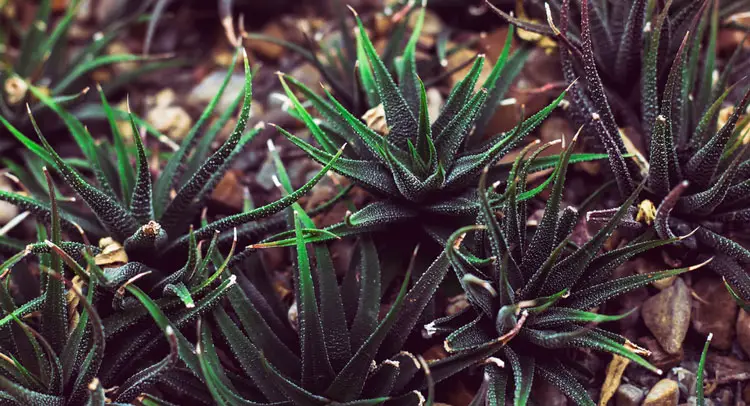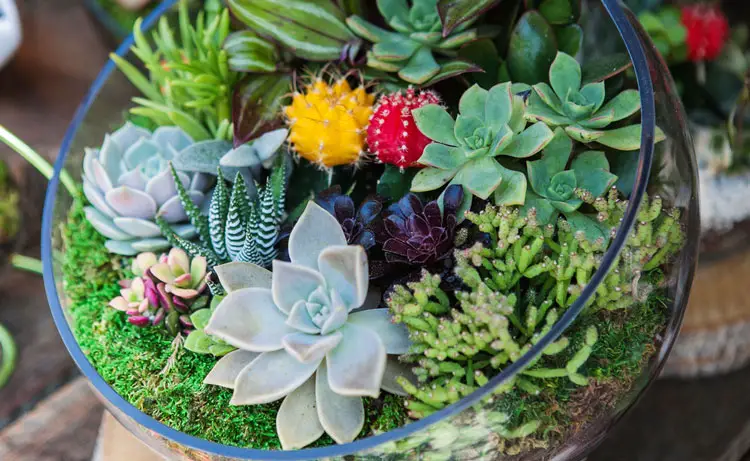Are air plants the same as succulents?

This post follows our research editorial guidelines.

Fluffy, fuzzy air plants are real charmers and a great addition for any plant collector. They remind me a lot of my other low-care favorites, the succulents. Just how alike are these two groups of plants, and how does that impact how you care for them?

Table of Contents
Are air plants part of the succulent family?
Air plants belong to the genus Tillandsia and are not related to succulents. They do however share striking similarities which often causes confusion among gardeners.
How are air plants different than succulents?
Air plants belong to the genus Tillandsia – they’re more closely related to bromeliads than they are succulents! This means that their biology is different enough that it’s going to have a big impact on how you grow them.
The biggest difference is the structure of the leaves. Air plants typically have hard, fibrous leaves with a tough outer layer. This thick skin helps them hold water and protect them from pests and disease. The leaf is also their main tool for drawing moisture and nutrients from the environment – their roots hardly warrant a mention at all.
Succulents on the other hand are juicy! Their leaves have evolved to hold as much water as they can within the leaf tissue, giving them thick, firm leaves beneath a thin, smooth skin. Their leaves are packed with special water holding tissue called hydrenchyma. Succulents have so much of this tissue it becomes a defining characteristic.
How to care for air plants
Air plants don’t ask for much. All the want is some bright light and a bit of water every now and then. air plants don’t need soil at all and will live quite cheerfully without it. Air plants ask for very little indeed and will thrive without any visible means of support. My grandmother furnished her 70s era kitchen with air plants that stuck to the fridge with a magnet – a real achievement that even the hardiest of succulents would struggle to match!
How to care for succulents
While you needn’t fuss over a succulent the way you might a more demanding plant like a calathea or a begonia, they still need a bit of attention. They have particular soil requirements, and they need as much light as you can throw at them. But in practice this means they’ll happily bask on a sunny ledge or porch with no more care required than the occasional drink.
They’re popular for good reason. “Succulents are beautiful, colorful and can add so much texture and visual interest to your landscape,” says David Hillock, Oklahoma State University Cooperative Extension consumer horticulturist. “Whether you’re a novice or a seasoned gardener, succulents are a great choice.”

How to water air plants
There’s a couple of ways to water air plants – misting, soaking or dunking.
The first is to give the air plant a light spritz once every other day with some distilled water applied with a mister. Always let them dry afterwards – water trapped at the base of leaves often causes rot.
You can also rinse them under a tap water twice a week. A quick swish and a shake is all it takes, and once they’ve dried you can put them back in their arrangement. Be mindful of water quality though – it’s common for tap water to have excess chlorine or fluoride in it that can cause problems for your plant.
Personally, I like to water my air plants in a nice warm bath. Fill a dish or bowl with clean, lukewarm water and let the air plant soak. 15 minutes once every two weeks or so is more than enough. Once they come out of their bath, tip them over to let them drain, and be sure to let them dry thoroughly before you put them back in their homes.
How to water succulents
Succulents also enjoy deep watering. I follow the practice of “lots, but not often”, as these are desert plants that have evolved to take advantage of summer storms with not much else between.
I put my succulents, pot and all, in a large tub or basin. Then I fill tub with lots of clean water, really saturating the soil. You should see lots of little bubbles, and once they stop rising you can remove the succulent from the tub.
For really dried out succulents you can leave them in there for a half an hour. Finally, pop them out and allow to drain before returning them to their place in the garden. For larger specimens you can get the same effect by watering the plant heavily until the excess is really flowing from the drainage holes.
I’ve seen this referred to as “drowning”, “dunking” or “swimming” a succulent, and its a great to really get those roots re-hydrated. It also knocks out pests in the soil, too, and helps keep any organic matter in the potting blend in good shape.
It’s important to allow the soil to dry completely between watering, however. Succulents have surprisingly fragile roots and are very prone to root rot. You’re always better off under-watering a desert plant like a succulent than you are over-watering it.
Feeding for air plants
Air plants are not heavy feeders. They really don’t want much fertilizer at all, and it would be very easy to burn their tiny roots with an excess of nitrogen and other salts found in chemical fertilizers.
If you’re looking to find out how to grow the biggest air plant, you’ll want to feed them from time to time. Once a month is enough, added to a bath or rinse. I’d suggest you stick to specialist bromeliad fertilizers to hit just the right balance of nutrients for these weird little plants.

Feeding for succulents
Succulents also don’t need a lot of fertilizer. During the spring and summer, it’s a good idea to add a half-strength dose of balanced liquid fertilizer to their regular watering, perhaps once a month. I just toss it in the basin with the water when giving them a good dip. They really aren’t that fussy, but if you want to grow the biggest succulents, keeping them fed will help.
Sun for air plants
Air plants prefer bright, indirect light, but aren’t too fussy about where it comes from. While sunlight is best for all plants, air plants will manage just fine under standard fluorescent lighting.
While they enjoy a short spell basking in early morning sunbeams, too much direct sunlight will dry them out. It’s best to keep these delicate little treasures out of the sun.

Sun for succulents
Succulents however love direct sun – in fact they’ll thrive outdoors on a sunny patio or deck. Provided they’re well hydrated, they can endure quite astonishing amounts of light and heat.
You may find your succulents changing color, too. Well-lit succulents will often develop a protective waxy layer called a farina, that gives them a silver cast. Others turn shades of pink, purple, orange or gold as the leaves flood with pigments that act as sunscreen. Many collectors deliberately sun their succulents, growing an entire rainbow of juicy leaved jewels.
Both air plants and succulents truly deserve their reputations as lovable, easy-care houseplants. While they differ in what they need, both will reward you for years to come with the right tender care.
